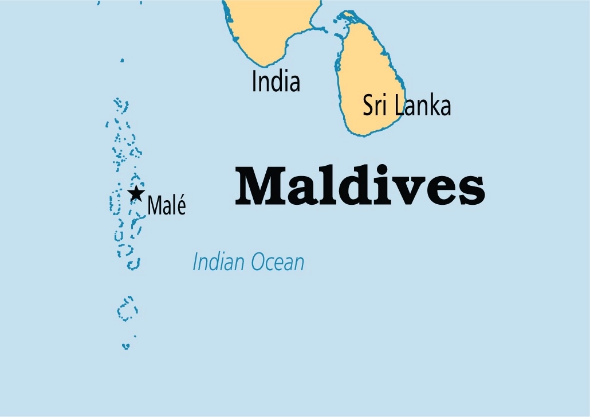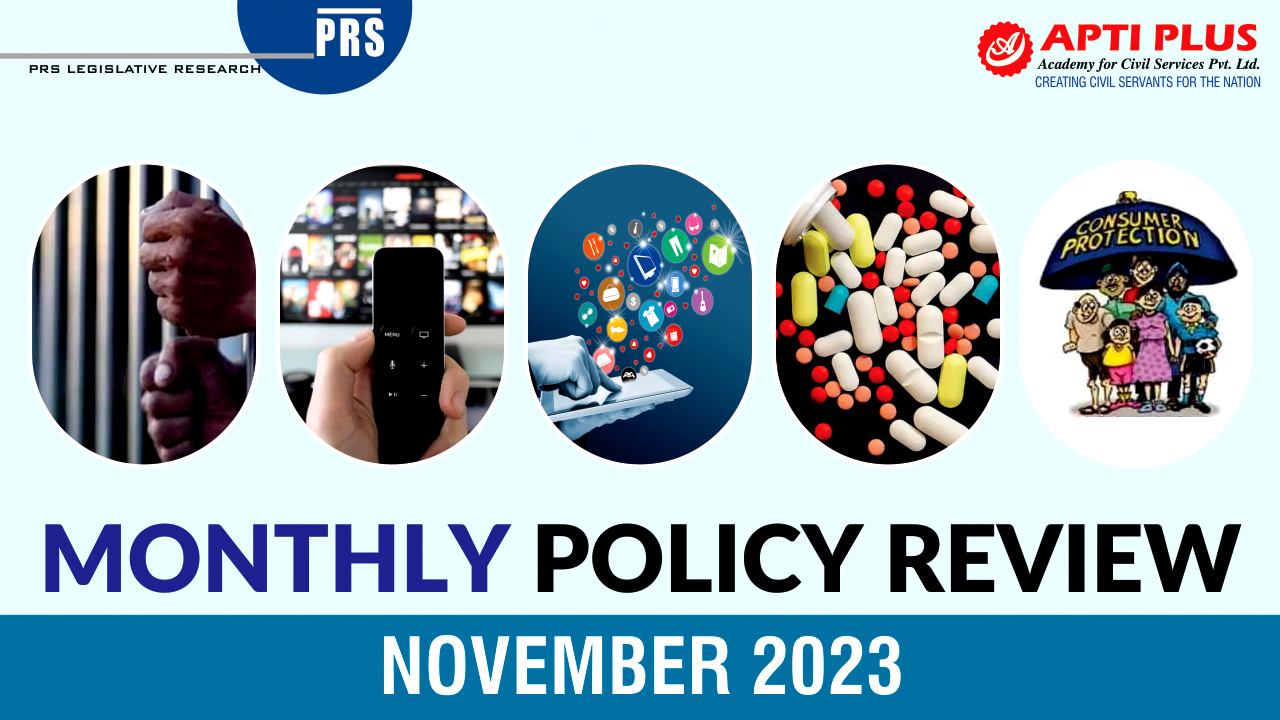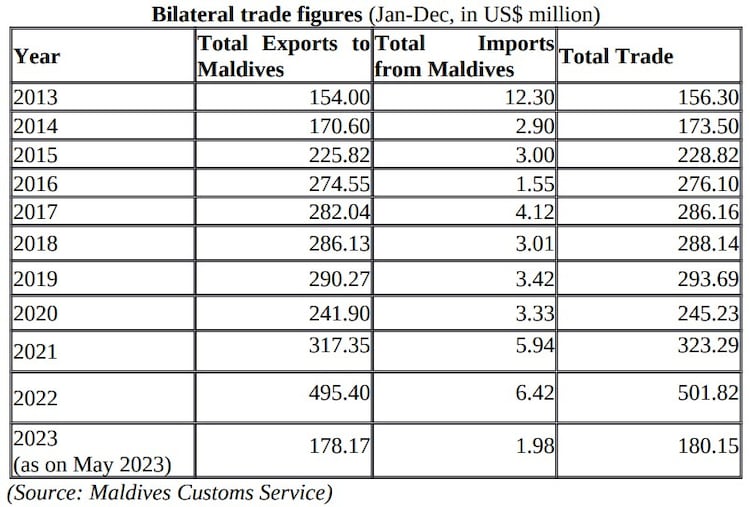
Disclaimer: Copyright infringement not intended.
Context
- India's relations with the Maldives, nosedived after three deputy ministers of the island nation made disparaging remarks about Prime Minister Narendra Modi's two-day visit to Lakshadweep, promoting it as a tourist hotspot.
India Maldives Relations
- India and the Maldives share a historically close and cordial relationship, characterized by cultural, economic, and strategic ties.
- The geographical proximity of the two nations in the Indian Ocean region has played a significant role in shaping their bilateral relations.
- India was among the first to recognize Maldives after its independence in 1965 and to establish diplomatic relations with the country. India established its mission at Malé in 1972.
Political Relations:
- Diplomatic Dialogues: Regular high-level visits between leaders of both nations demonstrate diplomatic commitment. In 2019, Indian Prime Minister Narendra Modi visited the Maldives, signifying the importance of bilateral ties.
- Political Dialogues: Continuous diplomatic dialogues address mutual concerns and promote cooperation. These discussions cover areas such as security, trade, and regional stability.

India's bilateral assistance to the Maldives:
Financial Assistance:
- India has provided substantial financial aid to the Maldives to support its economic development.
- Example: In 2018, India announced a financial assistance package of USD 1.4 billion for the Maldives, which included budget support, currency swap arrangements, and lines of credit for development projects.
Infrastructure Development:
- India has actively participated in infrastructure projects in the Maldives.
- Example: The INIA (Ibrahim Nasir International Airport) terminal project in the Maldives received support from India. This project aimed to enhance the capacity and facilities of the airport, contributing to the country's tourism and connectivity.
Healthcare Collaboration:
- As part of health diplomacy, India has supported the Maldives in enhancing its healthcare infrastructure.
- This assistance became particularly pronounced during the COVID-19 pandemic, with India supplying medical equipment, medicines, and COVID-19 vaccines to the Maldives.
Capacity Building and Training
- Capacity building and skills development is one of the key components of India’s assistance to Maldives. India offers several scholarships to Maldivian students under the following schemes:
- ICCR scholarships
- SAARC Chair Fellowship
- The Indian Technical and Economic Cooperation (ITEC) program is an example, offering training courses in various fields.
- Technical Cooperation Scheme of Colombo Plan
- Medical scholarships
- Several Maldivian diplomats have received training in India under the Indian Foreign Service Institute’s Professional Course for Foreign Diplomats (PCFD) program.
Tourism and Connectivity
- The restoration and expansion of the Maldives' Hanimaadhoo International Airport received financial support from India.
- This project aimed to improve air connectivity, benefiting the tourism sector.
Trade Facilitation
- The India-Maldives Free Trade Agreement, operational since 2011, facilitates trade by reducing tariffs and trade barriers, promoting economic cooperation between the two countries.
Climate Change and Environmental Initiatives
- India and the Maldives have collaborated on environmental initiatives, particularly in addressing climate change concerns.
- The Maldives' participation in the International Solar Alliance (ISA), led by India, is an example of joint efforts toward sustainable development.
Disaster Relief and Management
- In times of natural disasters, India has provided immediate assistance to the Maldives.
- For instance, after the 2004 Indian Ocean tsunami, India played a crucial role in relief and rehabilitation efforts.
Military and Maritime Cooperation:
- India and the Maldives engage in joint maritime exercises and defense cooperation. These efforts aim to enhance the Maldives' maritime capabilities for security and disaster response.
Some examples of joint maritime exercises and Defense Cooperation:
DOSTI (Friendship) Exercises:
- India and the Maldives have conducted joint naval exercises under the banner of "Exercise DOSTI." These exercises are aimed at enhancing interoperability between the naval forces of the two countries. Participants engage in various drills, including search and rescue operations, anti-piracy exercises, and communication drills.
MALABAR Exercise:
- While the MALABAR naval exercise traditionally involves the navies of India, the United States, and Japan, there have been instances where the Maldives has been invited to participate. MALABAR is a multilateral naval exercise focusing on maritime security, interoperability, and collaboration in the Indo-Pacific region.
Defense Cooperation Agreement:
- India and the Maldives signed a Defense Cooperation Agreement in 2016, outlining the framework for defense collaboration between the two nations.
- The agreement covers areas such as military training, joint exercises, and capacity-building initiatives.
Maritime Security Initiatives:
- Both countries work together on maritime security initiatives to counter common threats such as piracy, illegal fishing, and other transnational crimes.
- Information sharing and coordination in patrolling efforts contribute to the overall security of the Indian Ocean region.
Disaster Response and Humanitarian Assistance:
- Defense cooperation extends to disaster response and humanitarian assistance.
- Joint efforts are made to enhance capabilities for quick response and relief operations during natural disasters, which are particularly relevant for a geographically vulnerable nation like the Maldives.
Training and Capacity Building:
- India provides training and capacity-building support to the Maldives' defense forces.
- This includes training programs for Maldivian military personnel in various areas such as counter-terrorism, search and rescue operations, and disaster management.
Information Exchange:
- Regular exchange of information on maritime activities and security threats is a crucial aspect of defense cooperation.
- Both countries share intelligence to address common challenges and ensure the safety and security of their maritime interests.

Security And Defence
- Defence and security have been the bedrock of cooperation between India and the Maldives since 1988, and it was further consolidated after the signing of the Action Plan for Defence in April 2016.
- According to the Ministry of External Affairs (MEA), India provides around 70 percent of defence training requirements of the Maldivian National Defence Force (MNDF). In the last decade, India has trained over 1500 MNDF personnel besides providing air assets for air surveillance.
- Capacity building through joint exercises like the Ekuverin, Ekatha, and disaster management have also been part of defence cooperation.
- For India, the Maldives has acted as a first line of defense against terrorist activities, piracy, drug trafficking and other maritime crimes.
Tourism and People-to-People Ties:
- Tourist Arrivals: India is one of the significant contributors to Maldives' tourism. In 2019, before the pandemic, over 166,000 Indian tourists visited the Maldives, making India the second-largest source of tourists for the island nation.
- Connectivity: Improved air connectivity, including direct flights, has facilitated the movement of tourists between the two countries. This enhances cultural exchange and strengthens people-to-people ties.
Development And Infrastructure
- India is engaged in a host of infrastructure and development projects in the Maldives, ranging from airports at Hanimaadhoo and Gan Island, the Greater Male Connectivity Project, as well as the development of Gulhifalhu Port.
- The biggest project India is presently carrying out in the Maldives is the Greater Male Connectivity Project in which a 6.74 km-long bridge will connect the Maldivian capital Male with three adjoining islands of Villingli, Gulhifalhu and Thilafushi, reducing travel time. For this, India has sanctioned USD 500 million.
- Besides, India is also helping Maldives establish Addu as the southern tourism hub of the country through the construction of roads, street lighting, drainage, etc.
- Another big-ticket project includes the development of Gulhifalhu Port to shift the burden from the congested Male commercial harbor.
- The single-largest grant project being executed by India in the Maldives is the National College for Police and Law Enforcement for Rs 222.98 crore. India is also partly financing the restoration of Hukuru Miskiiy (Friday Mosque) in Male.

Healthcare And Education
- In the healthcare sector, India has provided Rs 52 crore for the development of Indira Gandhi Memorial Hospital besides helping set up a state-of-art cancer facility that will connect over 150 health centres on various islands.
- In education, India helped set up an Institute of Technical Education in 1996.
- India has also started a program to provide training to Maldivian teachers and youth and for vocational training in a USD 5.3 million project.
- Since 2019, over 2,200 Maldivians have visited India for various in-person training programs.
- India has also allotted 10 seats every year to the Maldives under its India Science and Research Fellowship programme.
Economy And Trade
- Trade between India and Maldives has grown by four times since PM Modi assumed office in 2014.
- In 2022, the total trade volume was USD 501.82 million compared to USD 173.50 million in 2014.
- The bilateral trade had crossed the USD 300 million mark for the first time in 2021, making India its third largest trade partner, as per Indian government data.
- Most of the trade has spiked following the launch of the cargo vessel service between the two nations in September 2020 besides the implementation of the visa-free entry scheme in 2022 for Indians arriving in the Maldives for business purposes.
- Being its closest neighbor, the Maldives is dependent on India for a host of essential commodities like rice, wheat flour, sugar, potatoes and onions, eggs, vegetables, and even construction material.
- On the other hand, scrap metals and seafood constitute a bulk of Indian imports.
- The State Bank of India is the largest in the island nation and has been playing a key role since 1974 by providing loans for resorts, the export of marine products, and business enterprises.
Tourism
- India is amongst the largest sources of visitors to the Maldives, which is heavily dependent on tourism to run its economy. In fact, according to the World Bank, tourism revenue accounts for almost one-third of its economy.
- In 2023, India topped the chart in sending the largest number of tourists to the Maldives (2,09,198), with around 11.8 per cent market share.
- In fact, since 2018, Indians have been the largest source of tourist arrivals. From being fifth in the list, India has now been at the pole position since 2020.
- Even in 2020, when the COVID-19 pandemic had strapped people to their couches, nearly 63,000 Indians visited the Maldives.
- The next two years saw over 2.91 lakh and 2.41 lakh Indian tourist arrivals, accounting for a whopping 23 per cent and 14.4 percent market share respectively.
- Most of this has been possible due to the Open Skies Arrangement signed in 2022.
Concerns in India Maldives Relations
Chinese Influence and Infrastructure Projects:
- Example: The Maldives has engaged with China on various infrastructure projects, including the construction of the China-Maldives Friendship Bridge. This has raised concerns in India about growing Chinese influence in the region.
- Data: As of 2019, Chinese foreign direct investment in the Maldives accounted for a significant portion of the country's total foreign direct investment, contributing to concerns about economic dependency and geopolitical implications.
Political Transitions and Uncertainties:
- Example: The Maldives has witnessed political transitions, including changes in leadership and governance structures. Such transitions can introduce uncertainties and potentially impact the continuity of policies and diplomatic relationships.
- Data: Political instability in the Maldives in 2018, marked by changes in government, led to concerns about the future direction of the bilateral relationship.
Debt and Economic Dependency:
- Large-scale infrastructure projects, often funded by external powers, can lead to concerns about debt and economic dependency. If the Maldives accumulates significant debt, it might affect its ability to make independent policy decisions, potentially impacting its relationship with India.
Security Challenges in the Indian Ocean:
- The Indian Ocean region faces security challenges such as piracy, illegal fishing, and other maritime threats.
- Ensuring maritime security and addressing these challenges collaboratively is crucial for both India and the Maldives, but differences in approaches or priorities may arise.
China's Expanding Presence:
- Example: China's Belt and Road Initiative (BRI) includes the Maldives, and its growing economic and strategic presence in the region has implications for India's security concerns.
- Data: China's investments in the Maldives, especially through the BRI, contribute to geopolitical shifts in the Indian Ocean, and monitoring the scale and nature of these investments is crucial for a comprehensive understanding.
Cultural and Diplomatic Sensitivities:
- Example: Cultural and diplomatic differences can sometimes impact relations. Navigating these sensitivities requires effective communication and cultural diplomacy.
- Data: Instances of cultural or diplomatic disagreements may be evident in diplomatic statements, but these are often qualitative and context-specific.
Way Ahead
Strengthening India-Maldives relations requires a comprehensive and strategic approach that encompasses various aspects of cooperation. Here are key measures that could contribute to strengthening ties between India and the Maldives:
Economic Cooperation:
- Trade Diversification: Identify and promote new areas of economic cooperation beyond traditional sectors, encouraging diversification in trade relations.
Infrastructure Development:
- Joint Infrastructure Projects: Collaborate on infrastructure development projects that contribute to the economic growth of the Maldives and enhance regional connectivity.
- Digital Connectivity: Explore opportunities for joint projects to improve digital infrastructure, promoting efficient communication and economic transactions.
Security Collaboration:
- Maritime Security Cooperation: Strengthen joint maritime exercises and security initiatives to address common challenges, ensuring the safety of sea lanes in the Indian Ocean.
- Information Sharing: Enhance mechanisms for real-time information sharing on maritime activities and security threats.
Climate Change and Environmental Initiatives:
- Renewable Energy Partnerships: Collaborate on renewable energy projects to address climate change concerns and promote sustainable development.
- Climate Adaptation Measures: Work together on climate adaptation strategies, including infrastructure projects to mitigate the impact of rising sea levels.
People-to-People Exchanges:
- Educational and Cultural Programs: Promote educational and cultural exchanges to deepen mutual understanding and strengthen people-to-people ties.
- Tourism Collaboration: Enhance tourism collaboration through joint marketing initiatives and cultural tourism programs.
Health Diplomacy:
- Collaborative Healthcare Initiatives: Strengthen healthcare cooperation, sharing best practices, and collaborating on research and development in the health sector.
- Pandemic Preparedness: Develop joint emergency response plans and protocols for pandemics and other health crises.
Strategic Dialogue and Diplomacy:
- Regular High-Level Dialogues: Maintain a robust schedule of high-level diplomatic dialogues to address emerging challenges and outline a shared vision for the future.
- Strategic Partnerships: Explore opportunities for strategic partnerships, emphasizing shared values and common goals in the Indo-Pacific region.
Security and Counter-Terrorism Measures:
- Defense Agreements: Strengthen defense cooperation agreements, focusing on intelligence sharing, joint military exercises, and capacity building in counter-terrorism efforts.
- Regional Security Initiatives: Collaborate on regional security initiatives to address common security threats and contribute to the stability of the Indian Ocean region.
Cultural Preservation and Heritage:
- Cultural Preservation Initiatives: Collaborate on initiatives to preserve and promote shared cultural heritage, fostering a sense of common identity.
- Heritage Tourism: Develop heritage tourism programs to showcase historical ties and enhance cultural exchanges.
Balancing External Influences:
- Transparent Diplomacy: Maintain transparent and open communication to address concerns related to external influences, ensuring that the relationship is built on mutual trust and respect.
- Engagement with Regional Allies: Strengthen ties with regional allies and partners, emphasizing a commitment to the stability and security of the Indian Ocean region.
By pursuing these measures, India and the Maldives can build a stronger, more resilient relationship that addresses mutual concerns and contributes to the shared prosperity and stability of the region. Continuous dialogue, collaboration, and a commitment to common goals will be essential for the long-term strengthening of bilateral ties.
|
PRACTICE QUESTION
Q. Discuss the dynamics of India-Maldives relations in the context of evolving geopolitical scenarios. Analyze the key factors influencing the bilateral relationship, including economic ties, security cooperation, and regional engagement. Assess the impact of external influences, with a particular emphasis on China's role, on the strategic partnership between India and the Maldives. Propose policy recommendations to strengthen and navigate the future trajectory of this critical bilateral relationship, taking into consideration shared regional interests and emerging challenges.
|















